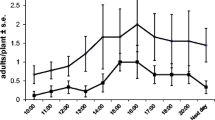Abstract
Prey preference of three phytoseiid species,Typhlodromus pyri Scheuten,Amblyseius potentillae (Garman) andA. finlandicus (Oudemans) which occur in Dutch orchards, was analysed with respect to two economically important phytophagous mites, the European red spider mitePanonychus ulmi (Koch), and the apple rust miteAculus schlechtendali (Nalepa). Two types of laboratory experiments were carried out: (1) olfactometer tests to study the response when volatile kairomones of both prey species were offered simultaneously; and (2) predation tests in mixtures of the two prey species and comparison with calculated predation rates, using a model provided with parameters estimated from experiments with each prey species alone. In addition, the diet of field-collected predators was analysed using electrophoresis.
For each predator species the results of the different tests were consistent, in thatT. pyri andA. potentillae preferredP. ulmi overA. schlechtendali, whereasA. finlandicus preferredA. schlechtendali overP. ulmi.
Similar content being viewed by others
References
Beddington, J.R., Free, C.A. and Lawton, J.H., 1978. Modelling biological control: on the characteristics of successful natural enemies. Nature, 273: 513–519.
Chant, D.A., 1959. Phytoseiid mites (Acarina:Phytoseiidae). Part I. Bionomics of seven species in Southeastern England. Can. Entomol., 91 (Suppl. 12): 1–44.
Comins, H.N. and Hassell, M.P., 1976. Predation in multi-prey communities. J. Theor. Biol., 62: 93–14.
Dicke, M., 1986. Volatile spider-mite pheromone and host-plant kairomone, involved in spaced-out gregariousness in the spider miteTetranychus urticae. Physiol. Entomol., 11: 251–262.
Dicke, M., 1988a. Prey preference of the phytoseiid miteTyphlodromus pyri. 1. Response to volatile kairomones. Exp. Appl. Acarol., 4: 1–13.
Dicke, M., 1988b. Infochemicals in tritrophic interactions. Origin and function in a system consisting of predatory mites, phytophagous mites and their host plants. Ph.D. Thesis, Agricultural University, Wageningen.
Dicke, M. and Groeneveld, A., 1986. Hierarchial structure in kairomone preference of the predatory miteAmblyseius potentillae: dietary component indispensable for diapause induction affects prey location behaviour. Ecol. Entomol., 11: 131–138.
Dicke, M. and de Jong, M., 1986. Prey preference of predatory mites: Electrophoretic analysis of the diet ofTyphlodromus pyri Scheuten andAmblyseius finlandicus (Oudemans) collected in Dutch orchards. Bull. IOBC/WPRS, 9: 62–67.
Dicke, M. and de Jong, M., 1988. Prey preference of the phytoseiid miteTyphlodromus pyri. 2. Electrophoretic diet analysis. Exp. Appl. Acarol., 4: 15–25.
Fitzgerald, J.D., Solomon, M.G. and Murray, R.A., 1986. The quantitative assessment of arthropod predation rates by electrophoresis. Ann. Appl. Biol., 109: 491–498.
Hassel, M.P., 1978. The Dynamics of Arthropod Predator-Prey Systems. Princeton Univ. Press, Princeton, NJ, 237 pp.
Hassell, M.P. and Comins, H.N., 1978. Sigmoid functional responses and population stability. Theor. Popul. Biol. 14: 62–67.
Kropczynska-Linkiewicz, D., 1971. Studies on the feeding of four species of phytoseiid mites (Acarina: Phytoseiidae). In: Proc. 3rd International Congress of Acarology, Prague, 1971, pp. 225–227.
McMurtry, J.A., 1982. The use of phytoseiids for biological control: Progress and future prospects. In: M.A. Hoy (Editor), Recent Advances in knowledge of the Phytoseiidae. Univ. California Press, Publication 3284, Berkeley, CA, pp. 23–48.
Murdoch, W.W., 1977. Stabilizing effect of spatial heterogeneity in predator-prey systems. Theor. Popul. Biol., 11: 252–273.
Murdoch, W.W. and Oaten, A., 1975. Predation and population stability. Adv. Ecol. Res., 9: 1–125.
Murray, R.A. and Solomon, M.G., 1978. A rapid technique for analysing diets of invertebrate predators by electrophoresis. Ann. Appl. Biol., 90: 7–10.
Nunney, L., 1980. The influence of type 3 (sigmoid) functional response and stability in predator-prey systems. Theor. Popul. Biol., 18: 257–278.
Overmeer, W.P.J., 1981. Notes on breeding phytoseiid mites from orchards (Acarina:Phytoseiidae) in the laboratory. Med. Fac. Landbouww. Rijksuniv. Gent, 46: 503–509.
Porres, M.A., McMurtry, J.A. and March, R.B., 1976. Investigations of leaf sap feeding by three species of phytoseiid mites by labelling with radiactive phosphoric acid (H3 32PO4). Ann. Entomol. Soc. Am., 68: 871–873.
Rabbinge, R., 1976. Biological Control of the Fruit Tree Red Spider Mite. Pudoc, Wageningen, 228 pp.
Roughgarden, J. and Feldman, M., 1975. Species packing and predation pressure. Ecology, 56: 489–492.
Sabelis, M.W., 1981. Biologicl control of two-spotted spider mites using phytoseiid predators. Part I: Modelling the predator-prey interaction at the individual level. Agric. Res. Rep. 910, Pudoc, Wageningen, 242 pp.
Sabelis, M.W., 1985. Predation on Spider Mites. In: W. Helle and M.W. Sabelis (Editors), Spider Mites, Their Biology, Natural Enemies and Control. World Crop Pests Vol. 1B, Elsevier, Amsterdam, pp. 103–129.
Sabelis, M.W., 1986. The functional response of predatory mites to the density of two-spotted spider mites. In: J.A.J. Metz and O. Diekmann (Editors), Dynamics of Physiologically Structured Populations. Lecture Notes in Biomathematics, 68; Springer, Berlin, pp. 298–321.
Sabelis, M.W. and Dicke, M., 1985. Long-range dispersal and searching behaviour. In: W. Helle and M.W. Sabelis (Editors), Spider Mites, Their Biology, Natural Enemies and Control. World Crop Pests. Vol. 1B, Elsevier, Amsterdam, pp. 141–160.
Sabelis, M.W. and van de Baan, H.E., 1983. Location of distant spider mite colonies by phytoseiid predators: demonstration of specific kairomones emitted byTetranychus urticae andPanonychus ulmi. Entomol. Exp. Appl., 33: 303–314.
Sabelis, M.W., Afman, B.P. and Slim, P.J., 1984. Location of distant spider mite colonies byPhytoseiulus persimilis: localization and extraction of a kairomone. In: D.E. Griffiths and C.A. Bowman (Editors), Proc. Sixth International Congress of Acarology, Edinburgh, 5–11 September 1982, Vol. 1. Ellis Horwood, Chichester, pp. 431–440.
Van Lenteren, J.C., 1986. Evaluation, mass production, quality control and release of entomophagous insects. In: J.M. Franz (Editor), Biological Plant and Health Protection. Gustav Fischer, Stuttgart, pp. 31–56.
Author information
Authors and Affiliations
Rights and permissions
About this article
Cite this article
Dicke, M., Sabelis, M.W. & de Jong, M. Analysis of prey preference in phytoseiid mites by using an olfactometer, predation models and electrophoresis. Exp Appl Acarol 5, 225–241 (1988). https://doi.org/10.1007/BF02366096
Accepted:
Issue Date:
DOI: https://doi.org/10.1007/BF02366096




